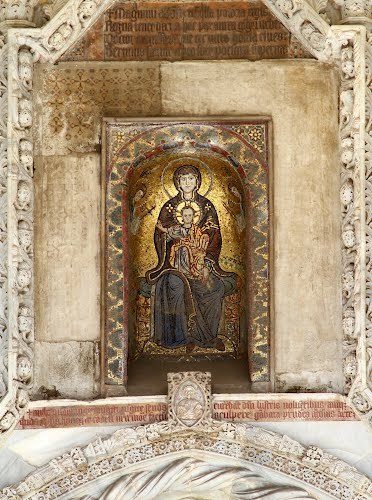
L'icône de la Mère de Dieu "DU SAPIN DE TCHERNIGOV" ("ELIETSKAÏA") (1060).
L'icône de la Mère de Dieu "DE SICILE" ("SITSILISKAÏA", "DVINOGORSKAÏA") (1092).
Si dice che Senofonte e Joasaf vivessero in una grotta (dove poi fu costruita la chiesa di San Giovanni il Precursore), e che avessero scavato la prima chiesa in una colonna calcarea, in cui deposero anche l’icona della Madre di Dio Sitsiliskaja (Siciliana), che avevano portato con loro. Questo è anche il luogo dove trovarono il loro riposo eterno. Nell’Icona della Madre di Dio Divnogorskaja-Siciliana, la Theotokos è raffigurata seduta tra le nubi. Nella mano destra regge un fiore di giglio bianco, e con il braccio sinistro sostiene il Divino Bambino, che siede ritto sulle sue ginocchia. Il Salvatore tiene un fiore di giglio nella mano sinistra, e benedice con la mano destra. Intorno alla figura della Madre di Dio sono otto angeli. Due al di sotto sono in ginocchio e con le mani levate in preghiera. Sopra il capo della Vergine il Santo Spirito in forma di colomba. La speciale glorificazione dell’icona ebbe inizio nell’anno 1831, quando infuriava il colera. A Korotoyak, 7-8 verste dal monastero, la Santissima Vergine apparve in sogno (così come è ritratta nell’Icona Divnogorskaja) ad un’anziana donna, Ekaterina Kolomenska. Ordinò che la sua icona venisse portata lì e si celebrasse un Molieben innanzi ad essa. L’icona miracolosa venne portata a Korotoyak, e dopo che fu celebrato il Molieben innanzi alla santa icona il colera cessò. Per l’intercessione della Madre di Dio, anche la città di Ostrogožsk fu salvata dal colera. La gente di Korotoyak e Ostrogožsk fu salvata dal colera anche nel 1847 e 1848 per l’intercessione miracolosa della Madre di Dio, che si verificò dopo una processione con la santa icona dalla chiesa verso queste città. Secondo la tradizione il 5 febbraio, giorno della festa dell’icona miracolosa, era già stato stabilito dai santi Senofonte e Joasaf quando l’icona si trovava nella sua dimora originaria.  Mosaico sul portico meridionale della Cattedrale di Palermo. http://www.ortodossiatorino.net/DocumentiSezDoc.php?cat_id=30&id=4381 Adattamento di un articolo tratto da Tradizione cristiana. https://fosilaron.tumblr.com/post/77056891360/licona-della-madre-di-dio-divnogorskaja-siciliana
The Divnogorsk-Sicilian Icon of the Mother of God received the first part of its title from where it was enshrined when it was glorified: the Dormition monastery of Divnogorsk, in the former Ostrogozhsk district in Voronezh governance. Its title of "Sicilian" comes from its place of origin, since by tradition this icon at Diva (i.e. "Wondrous Heights") was brought from Sicily by the pious monastic Elders Xenophon and Joasaph. They suggest that these saints were Orthodox Greeks by birth, and that they had arrived there not earlier than the end of the fifteenth century. Xenophon and Joasaph founded a monastery at a scenic spot above the River Don, near the confluence of the River Tikha Sosna [Quiet Pine River]. The place was called Wondrous Heights by those struck by the form of the chalk columns throughout the hills.
It is said that Xenophon and Joasaph lived in a cave (where later the church of St John the Forerunner was built), and that they carved out the first church in a chalk column, into which also they put the Sicilian Icon of the Mother of God which they had brought with them. Here is where they found their eternal repose. On the Divnogorsk-Sicilian Icon of the Mother of God, the Theotokos is depicted sitting in the clouds. In Her right hand is a white lily blossom, and with Her left arm She supports the Divine Infant, Who sits upright upon Her knees. The Savior holds a lily blossom in His left hand, and blesses with His right hand. Around the face of the Mother of God are eight angels. The two beneath are shown on bended knee and with hands upraised in prayer. Over the head of the Theotokos is the Holy Spirit in the form of a dove. The special glorification of the icon began in the year 1831, when cholera was raging. At Korotoyak, 7-8 versts from the monastery, the Most Holy Virgin appeared (as She is depicted in the Divnogorsk Icon) to a certain elderly woman, Ekaterina Kolomenska, in a dream. She commanded that Her icon be brought and a Molieben be served before it. The wonderworking icon was brought to Korotoyak, and after a Molieben before the holy icon, the cholera ceased. By the intercession of the Mother of God, the city of Ostrogozhsk also was saved from cholera. The people of Korotoyak and Ostrogozhsk were also saved from cholera in 1847 and 1848 through the miraculous intercession of the Mother of God, which occurred after a church procession around these towns with the holy icon. According to Tradition, the feastday of the wonderworking icon on February 5 was established already at its original habitation by Xenophon and Joasaph. L'icône de la Mère de Dieu "QUI RETROUVE CEUX QUI SONT PERDUS" ("VSYKANIE POGUIBCHIKH") (1707).  (Office traduit en français par le père Denis Guillaume au tome II du Supplément aux Ménées. Acathiste traduit en français par le père Denis Guillaume au tome XIII du Supplément aux Ménées.) |
Nessun commento:
Posta un commento
Nota. Solo i membri di questo blog possono postare un commento.